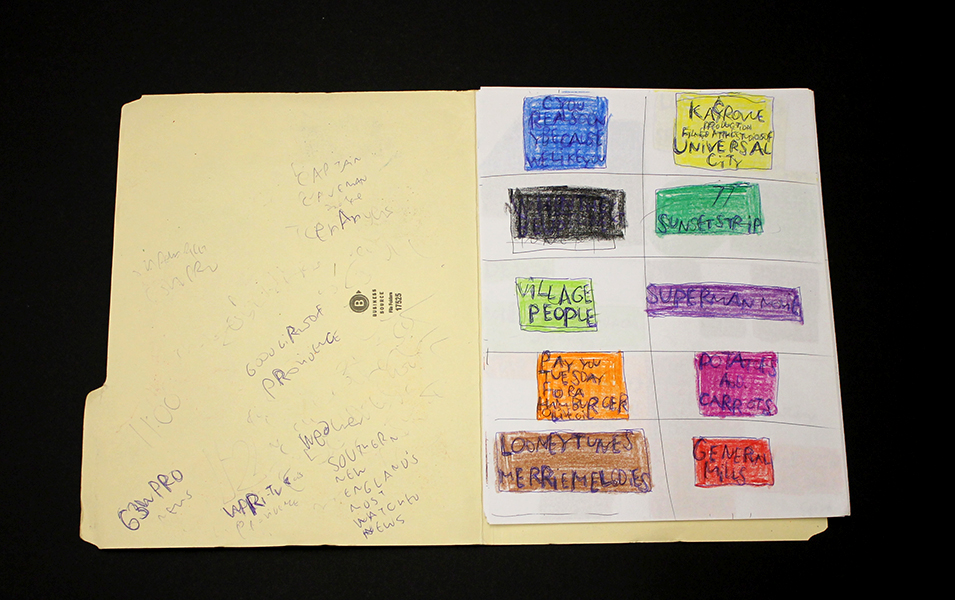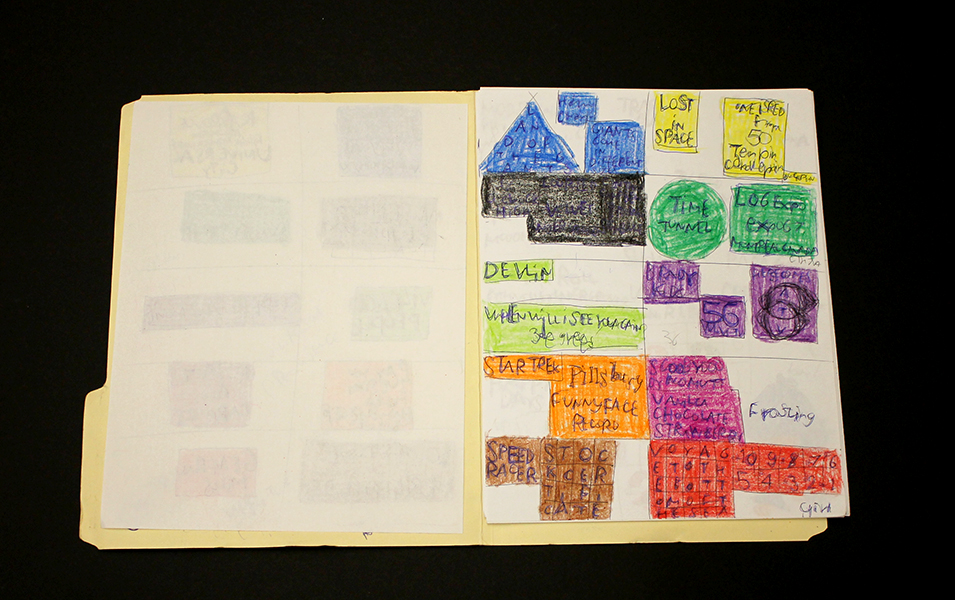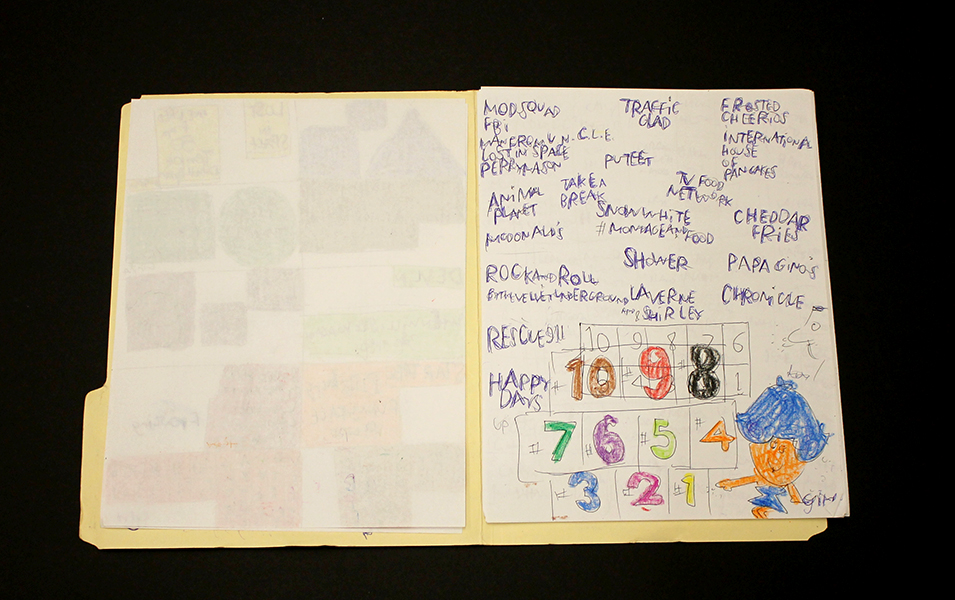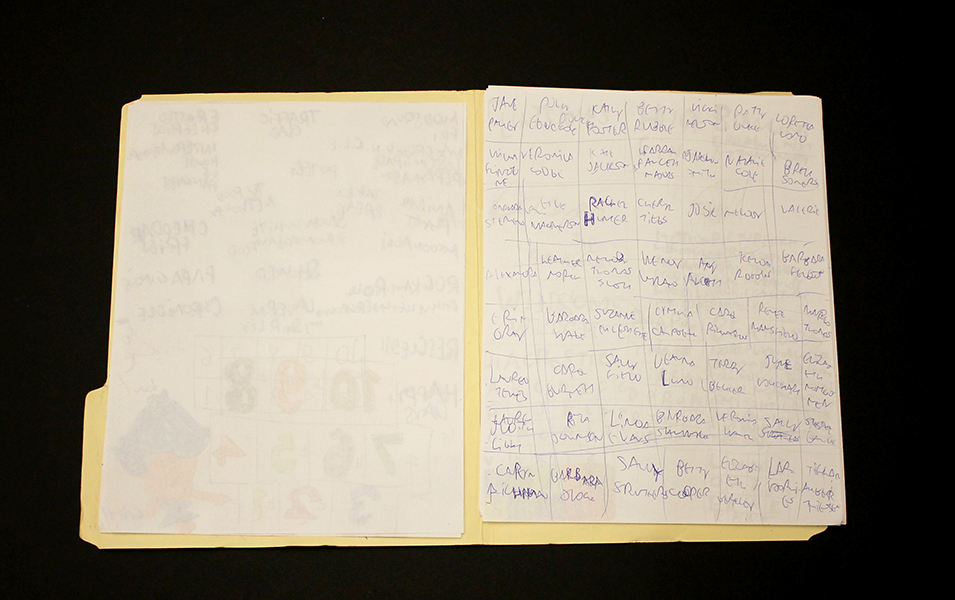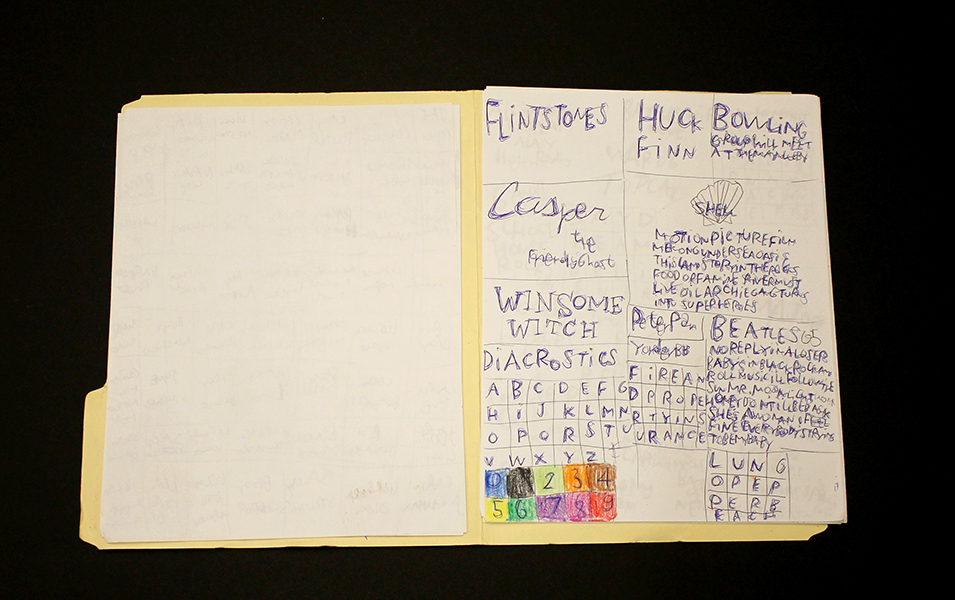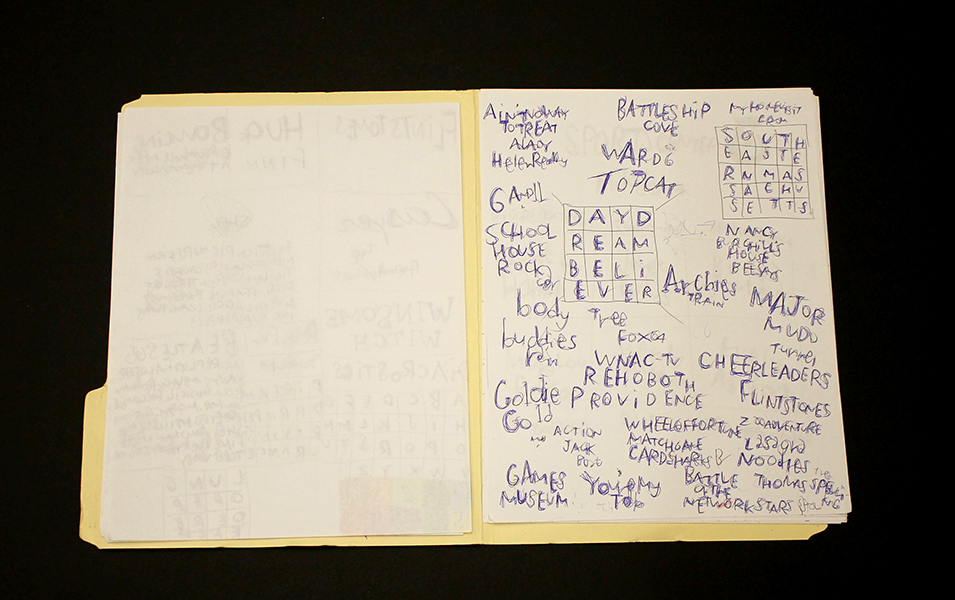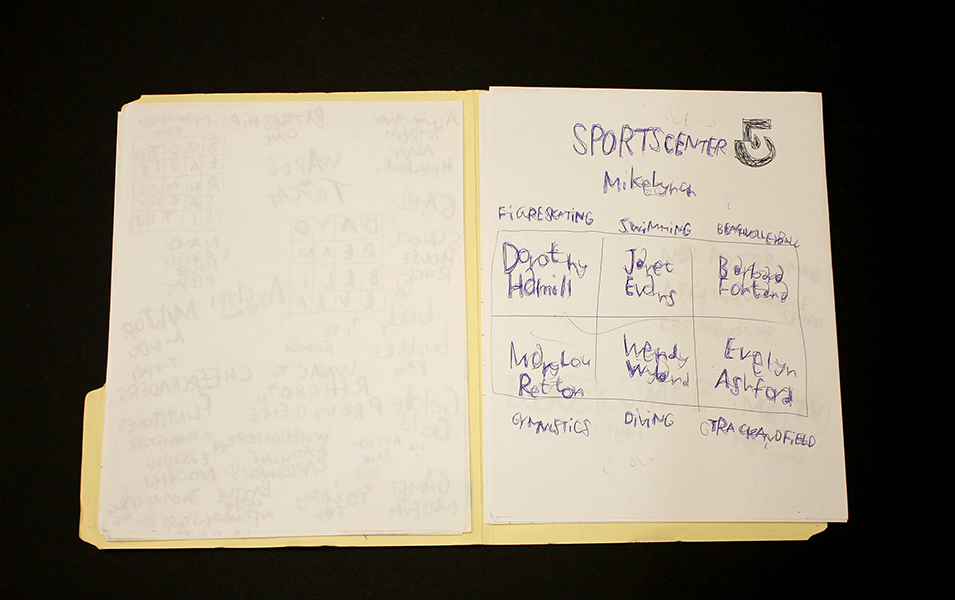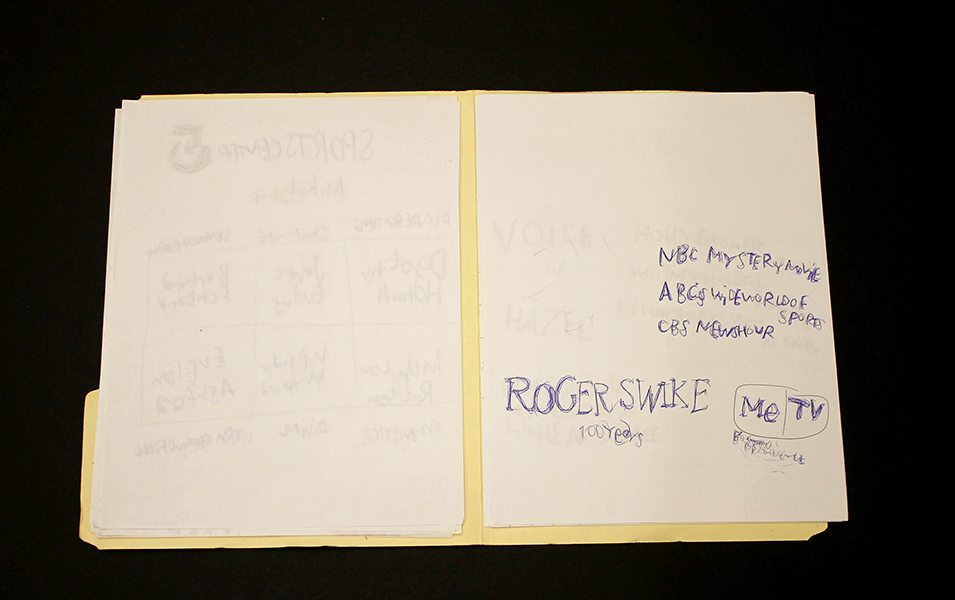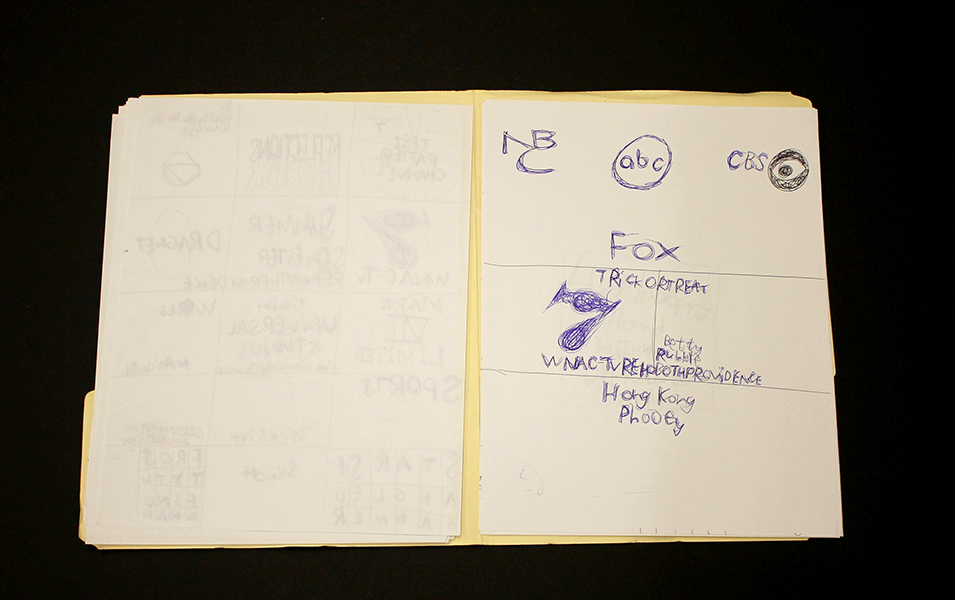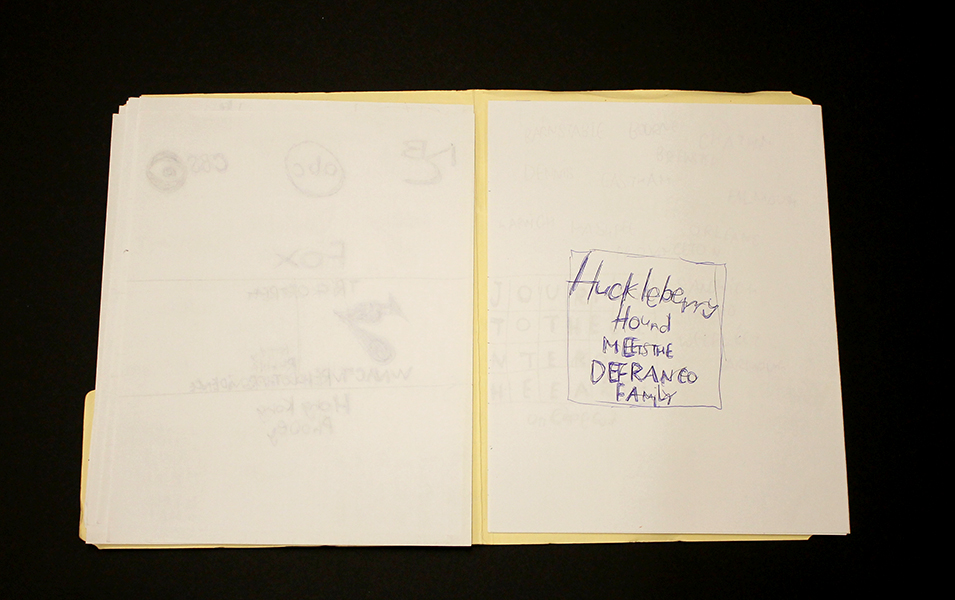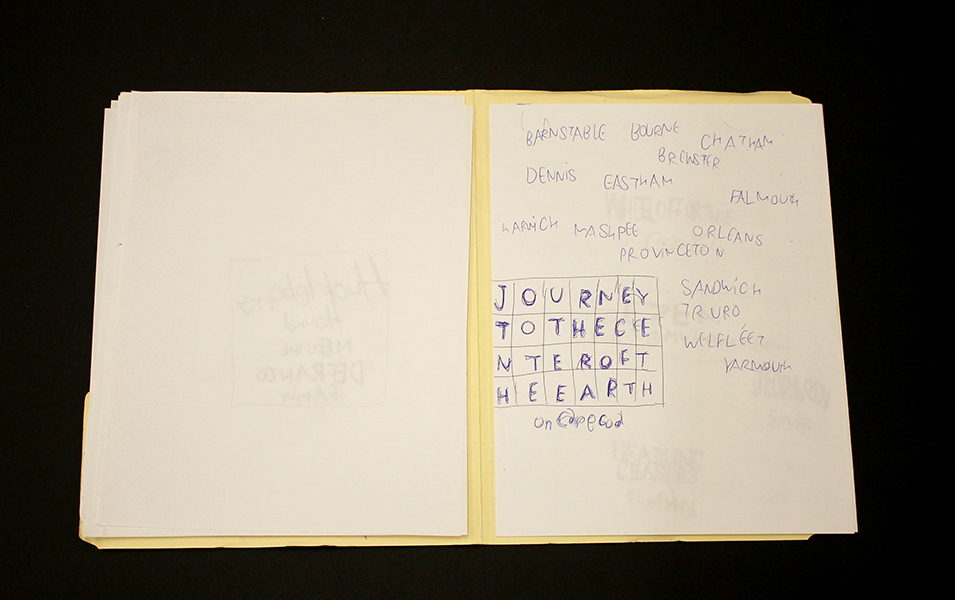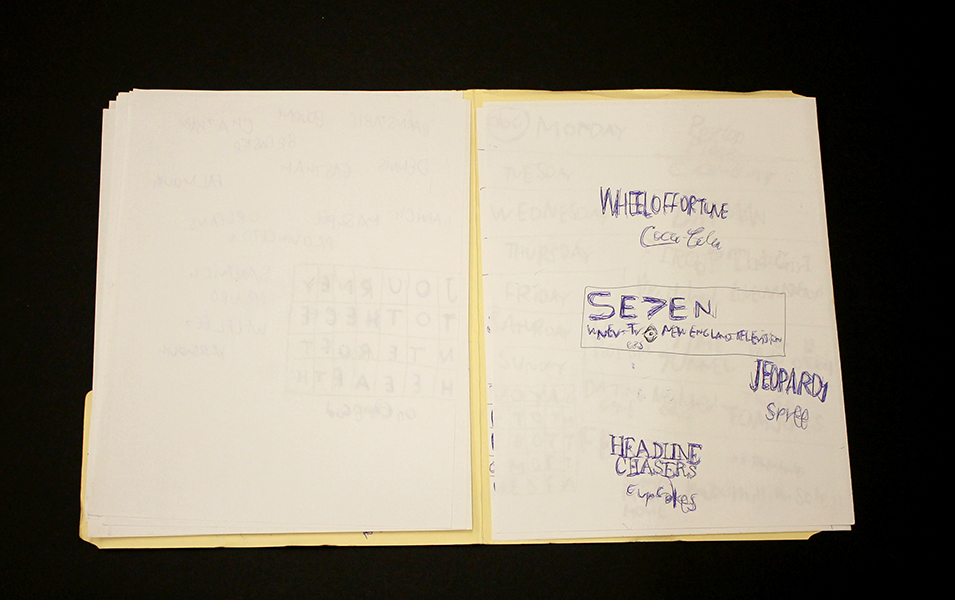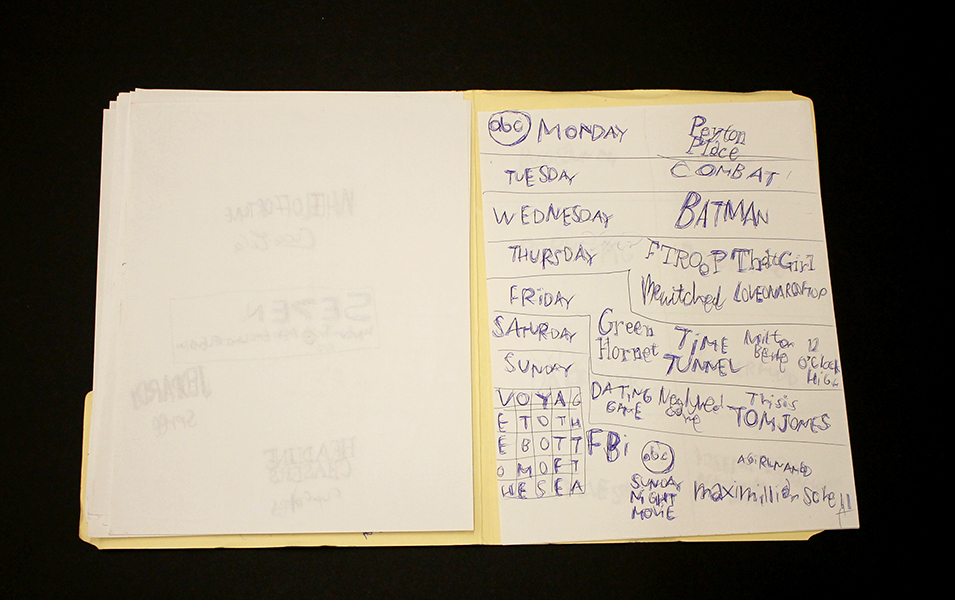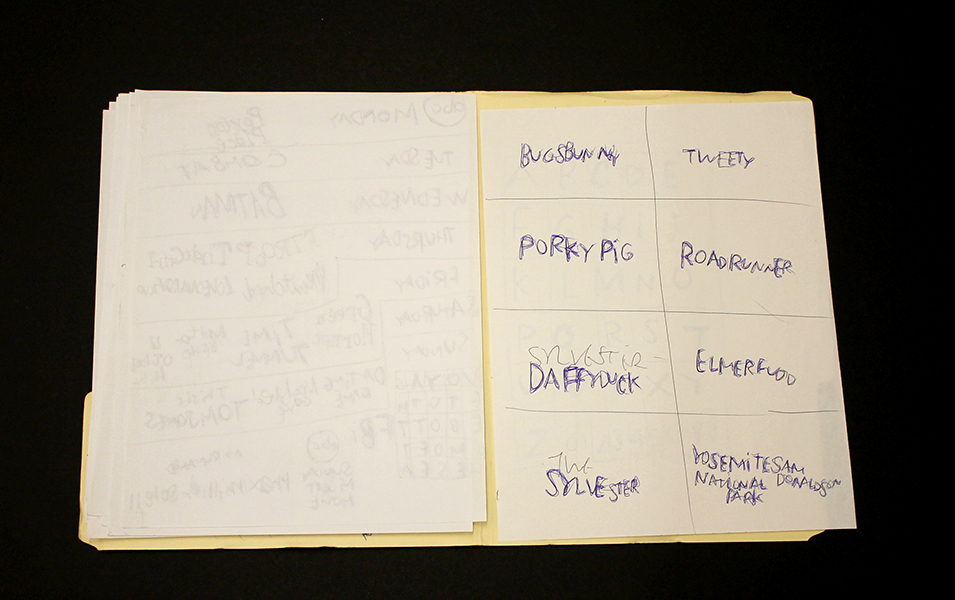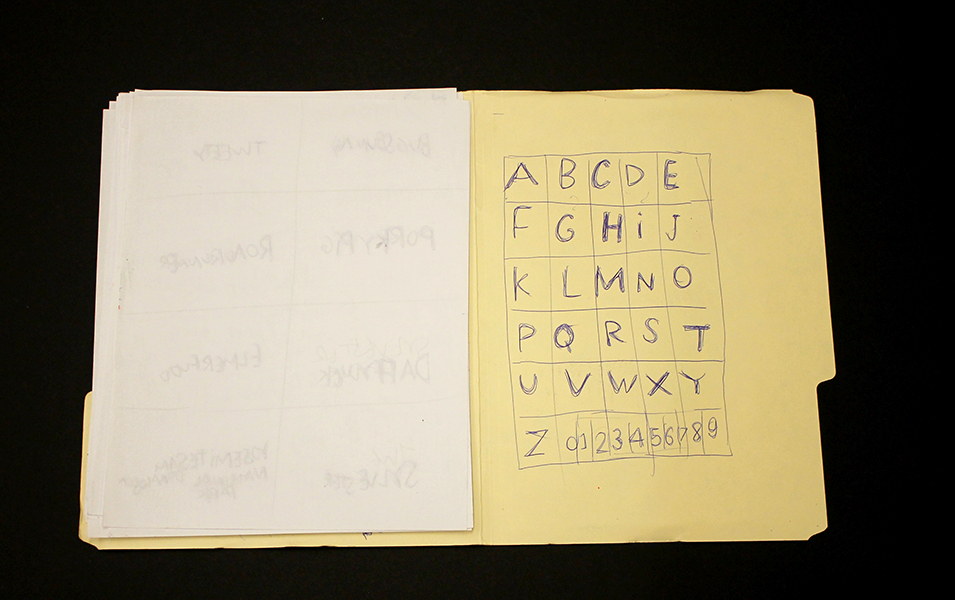We first encountered Sara Malpass’ work at NIAD in her solo exhibition What Are Words For, and have included her work in our latest curatorial project Storytellers, currently on view at LAND in Brooklyn. Selections by Malpass are featured in this exhibition in order to highlight the important perspective she offers in the discussion of narrative...
Read MoreStorytellers at LAND
Storytellers is a selection of works by artists who reimagine and reinvent the essential practice of telling stories through visual art. Each work represents aspects of a complex personal narrative, glimpses into alternate realities created with diverse materials and processes...
Read MoreAlan Constable
Alan Constable has been creating and exhibiting work in various media for the past thirty years, including painting and drawing, but it is the extensive body of ceramic works he has formed over the past decade that has increasingly garnered attention and acclaim...
Read MoreDisabled Artists Show Us a Way Forward Against a Trump Adminstration
The rise of Donald Trump over the past year has been for us, like many, a growing dread - not wanting to believe that America would really elect an unfit candidate, while watching both political parties and the news media self-destruct in the face of a changing world....
Read MoreOn Identity Politics and Self-Taught Artists
In a recent essay “How Identity Politics Conquered the Art World, An Oral History”, Jerry Saltz and Rachel Corbett strive to make sense of our current pluralistic era of contemporary art by constructing a narrative in which the 1993 Whitney Biennial marks the establishment of a new direction for art-making, a movement they describe as “the art of the first person”.
“After the ’80s, we seem to have lost the reflex to recognize or name new art movements — maybe because in the sprawling new art ecology there were so many isms sprouting at once; plus we’ve always categorized things by formal, medium-based, and geographical attributes. But something has happened here, over the last 25 years, that I am sure will be recognized with great clarity by art-history students very soon. Art in this era has veered dramatically toward an approach that hasn’t been seen in the West for more than 1,000 years: a concerted urge, almost a rage, to be totally communicative to the largest possible audiences, addressing cognoscenti, novices, and newcomers in the same register, telling stories of social, political, and philosophical conditions. Of course, not everybody today is making this kind of work. But taken together, it does constitute a real aesthetic movement, one that is biographical, autobiographical, personal — the art of the first person.”
In this narrative, "the art of the first person" is the product of an increased focus on identity politics in contemporary art. The ‘93 biennial was “reviled” with an intense rejection of the perceived abrasiveness of its political works, but Saltz and Corbett describe a significant shift that occurs in the 90s as a result of what was underlying a new approach to thinking about art and identity.
“For the first time, biography, history, the plight of the marginalized, institutional politics, context, sociologies, anthropologies, and privilege have all been recognized as “forms,” “genres,” and “materials” in art. Possibly the core materials.”
The history that Saltz and Corbett lay out is elaborate, well researched, and very compelling. However, there is a crucial piece missing where the emergence of “new forms” and “materials” derived from marginalization and identity is conflated with the “Rage, to be totally communicative to the largest possible audiences”; that missing piece is "Neurodiversity". This concept, which has been used in recent years to describe the goals of disability rights advocacy, often goes unmentioned in the identity politics discourse. In an essay regarding identity politics and disability studies Anna Mollow writes:
Paradoxically, the construction of disability as a minority identity is often impelled by the desire to gain recognition for disability as a concept of universal importance: Siebers, Davis, Thomson, and other disability scholars have called attention to the marginalization of disability within academic conversations and then argued powerfully for its inclusion within these conversations. Following their example, we must continue to foreground academic inattention to disability. At the same time, we must insist upon the relevance of disability to a wide range of contemporary theoretical and political discussions. (source)
The concept of Neurodiversity emerged in the late 90s from the Autism Rights Movement and its intention to catalyze the recognition and acceptance of those who are neurologically divergent from the majority of the population. Furthermore, it asserts that neurological differences should be respected as a marginalized social category equal to those of ethnicity, gender, and sexual orientation. What Neurodiversity proposes, though, is much broader and more profound than autistic self-advocacy or even disability rights advocacy. It sets a new standard for what it means to appreciate the tangible power and value of diversity, leaving no room for the concessions or weaknesses of past identity politics movements. Neurodiversity doesn’t permit the possibility of assimilation; it requires that individuals in our society not only coexist while being essentially different from one another in profound ways, but actively strive to accommodate those disparities.
The context of Neurodiversity allows us to understand that "the art of the first person" is actually art made for a “broader” audience as a consequence of making art for an “other” audience. It’s not necessarily the case that an “other” artist aspires to appeal to a “broader” audience, but a “broader” audience becoming more diverse as it includes “others” that has the effect of making the their audience broader. An “other” artist appealing to an “other” audience was an “outsider” artist, so the “the art of the first person” works toward dismantling the possibility of outsiderism.
David Hammons, described by Saltz and Corbett as the godfather of the identity politics movement, has created work that addresses a broader audience in as much as it engages social issues that we're all familiar with. At the same time, though, it expresses concepts that people of color can understand and experience, but that white viewers can only speculate about. This sets a precedent for including artists who are engaging concepts that not all viewers can experience equally, or with the same directness, which permits a new way of thinking about the work of artists like Thornton Dial or Lonnie Holley (who are still marginalized and lumped into outsider categories) - no longer as artifacts from a separate world, but work created by an artist who is present and participates in our world, which we appreciate across a significant disparity of mind or circumstances. While the marginalization of Dial and Holley is the result of race, class, or geography, in the case of artists with disabilities, it's due to brains that function differently.
David Hammons, In the Hood, 1993, currently on view in Non-Fiction at The Underground Museum in LA
Whereas, artists like David Hammons actively strive to create a bridge to a broader audience by making works that appeal to mainstream contemporary art (the broader audience) that simultaneously speak in distinctly black voice (to the “other” audience). On a deeper level ,the inclusion of this work isn't driven by social justice alone, but rather the drive of contemporary art to rethink and break down its boundaries in search of ideas and practices that are more deliberate, absolute, innovative, and unrestricted by convention or culture.
Often described loosely as an outsider by critics and dealers due to his ambivalence toward and rejection of art world protocol, Hammons has always been open about his appreciation for self-taught artists and the influence they’ve had on his work. Outside Insight, a ground-breaking yet under-appreciated 1988 exhibition at MoMA’s Clocktower (that Hammons co-curated with Ed McGowin), championed the work of outsider artists that they sought out in rural North Carolina.
Although “Outside Insight” has received relatively little critical attention, the exhibition captures an important chapter in the development of Hammons’ artistic sensibility. “Outside Insight” evinces his identification with vernacular African-American cultural forms, self-effacing relationship to authorship, and profound sense of the value of everyday objects and gestures. (source)
Creating compelling contemporary work now requires an extreme abandoning of convention due to the expectation of producing “art of the first person”, which requires contemporary artists to fully re-invent art for themselves - finding new ways of thinking and being while teaching themselves within this new context (such as Theaster Gates' urban planning research).
Installation view of Marlon Mullen's recent solo exhibition at Adams and Ollman in Portland, Oregon, image courtesy NIAD
Strangely, progressive art studios aren’t recognized as fitting into the increasingly popular social practice/socially engaged fields of art, even as artists who come from this radical model (notably Judith Scott, Marlon Mullen, William Scott, Helen Rae, and Julian Martin) are being represented by and exhibited at prominent galleries and museums. Unlike Hammons, many contemporary artists seem hesitant or uncomfortable citing these artists despite obvious influences in their work, or worse, find it unnecessary. Critics, with the exception of Saltz, David Pagel, and a few others, are hesitant to write about current work by self-taught artists, especially through the lens of contemporary art. As a result, the art historical canon still doesn’t accurately reflect the contributions of these artists (especially those with disabilities).
Understanding the emergence of “the art of the first person” is incomplete without including the convergence of outsiders into the mainstream, as well as the shifting focus within outsider art to living artists, especially self-taught developmentally disabled artists facilitated by trained, neurotypical peers in progressive art studios, where the most extreme disparities between the contemporary mainstream and the “other” are simultaneously transgressed and maintained.
Mapping Fictions: Daniel Green
Daniel Green, Fifteen People, 2009, Mixed media on wood, 14.25 x 22.5 x 1.75 inches
Daniel Green, Little Mac vs Soda Poponski, 2015, mixed media on wood, 11.5 x 15 inches
Daniel Green, The Sun, 2015, mixed media on wood, 6 x 16.5 x 1 inch
Daniel Green, Business Delivery, 2011, Mixed media on wood, 13 x 29 x 1 inches
Daniel Green's process is slow and intimate; quietly hunched over his works in the bustling studio, he draws and writes at a measured pace. These detailed works are an uninhibited visual index of Green’s hand; when read carefully, they become jarring and curious, slowly leading the viewer to meaning amid the initial incoherence. Green’s text is poetic and complex - language and thought translated densely from memory in ink, sharpie, and colored pencil on robust panels of wood. Figures and their embellishments are drawn without a hierarchy in terms of space occupied on the surface; they are at times elaborate and at other times profoundly simple. The iconic figures’ facial expressions (Jesus, Abraham Lincoln, Tina Turner, video game characters, etc.) are generally flat with proportions stretching and distorting subject to Green’s intention.
Ultimately, these drawings compel the viewer to internalize and decipher Green’s ongoing, non-linear narrative. His drawings call to mind Deb Sokolow’s humorous, text-driven work, but are less diagrammatic and concerned with the viewer. In an interview with Bad at Sports’ Richard Holland, Sokolow elaborates on her process:
I’ve been reading Thomas Pynchon and Joseph Heller lately and thinking about how in their narratives, certain characters and organizations and locations are continuously mentioned in at least the full first half of the book (in Pynchon’s case, it’s hundreds of pages) without there being a full understanding or context given to these elements until much later in the story. And by that later point, everything seems to fall into place and with a feeling of epic-ness. It’s like that television drama everyone you know has watched, and they tell you snippets about it but you don’t really understand what it is they’re talking about, but by the time you finally watch it, everything about it feels familiar but also epic. (Bad At Sports)
Much like Sokolow, Green engages in making work that begins with the rigorous practice of archiving information culled from his surroundings and interests, which then develops into intriguing, fictitious digressions. Dates and times, tv schedules, athletes, historical figures, and various pop culture references flow through networks of association - “KURT RUSSEL GRAHAM RUSSEL RUSSEL CROWE RUSSEL HITCHCOCK AIR SUPPLY ALL OUT OF LOVE…” Although the listing within his work sometimes gives the impression of being intuitive streams of consciousness, most of it proves to be very structured and complex within Green’s system. Rather than expression or even communication, the priority seems to be the collection of information or organization of ideas; the physical encoding of incorporeal information as marks on a surface is a method for making it tangible, possessable, and manageable.
Daniel Green, Pure Russia, 2011, Mixed media on wood, 9 x 23 x 3.5 inches
Pure Russia (detail)
From the perspective that Green invents, there’s an endless number of time sequences that haven’t been considered before. A grid of days and times (as in Pure Russia) imagines time passing in increments of one day and several minutes, then returns to the beginning of the series, stepping forward one hour, and proceeding again just as before. It could be cryptic if you choose to imagine these times having a relationship to one another, or it could instead be an original rhythm whose tempo spans days, so that it can only be understood conceptually as an ordered structure mapped through time - the significance of the pattern superseding that of specific moments.
By blurring the distinction between the articulation of ideas through text and the development of mark-making, Green’s highly original objects become unexpectedly minimal and material, yet simultaneously personal and expressive.
Daniel Green’s work will be included in Mapping Fictions, an upcoming group exhibition opening July 9th at The Good Luck Gallery in LA, curated by Disparate Minds writers Andreana Donahue and Tim Ortiz. Green has exhibited previously in Days of Our Lives at Creativity Explored (2015), Create, a traveling exhibition curated by Lawrence Rinder and Matthew Higgs that originated at University of California Berkeley Art Museum and Pacific Film Archive (2013), Exhibition #4 at The Museum of Everything in London (2011), This Will Never Work at Southern Exposure in San Francisco, and Faces at Jack Fischer Gallery in San Francisco.
Mapping Fictions: Roger Swike
Untitled, ballpoint pen on paper, 12 x 9 inches
Untitled, ballpoint pen and crayon on paper, 12 x 9 inches
Untitled, ballpoint pen and crayon on paper, circa 2013 12 x 9 inches
Roger Swike's ten crayons
Roger Swike is an exceptionally prolific artist who works rapidly on many pieces simultaneously; much like Melvin Way, his drawing process channels an immediate and intuitive stream of information, yet is also executed with deliberation and great intention. Swike will often revisit drawings created at different times and deliberately organize them into various color-coded folders; the resulting works are an assertive, endearing proposition about what an art object can be. Within content that initially appears chaotic or arbitrary, familiar text referring to pop culture and the exterior world is pervasive. Black and blue ballpoint pens and ten crayons are utilized as though each tool has a symbolic role. Some ideas are organized neatly into grids, others are written in less regimented clusters or lists, primarily in multiple layers of ballpoint pen. Over time, curious relationships and subtle patterns emerge, such as references to the number 7 or numbers listed on their own counting down from ten (but when listed alongside the alphabet they ascend from 0 to 9).
Because Swike’s work is disciplined and systematic, the viewer is tempted to decipher the rigid system that defines it, but the true nature of the work seems to reside in the plasticity of its rules. A grid listing Loony Toons characters deviates from the pattern to include "YOSEMITE NATIONAL PARK SAM DONALDSON", numbers are written in black ballpoint pen without an overlapping of blue pen, words or phrases are redacted, yet the sequence and grid are still drawn using the ten selected colors…often it feels as though Swike isn't creating the system, but instead exploring it as a poet does language, both fluent and curious. Each time Swike's lexicon is revisited, it presents an opportunity to rethink its mysterious nature - possibly an archive, message, map, poem, or something else entirely.
Roger Swike’s work will be included in Mapping Fictions, a group exhibition curated by Disparate Minds writers Tim Ortiz and Andreana Donahue at the Good Luck Gallery in LA, July 9 - August 27. Swike (born in Boston, 1962) has shown previously at the Berenberg Gallery in Boston, Fuller Craft Museum, the Outsider Art Fair, Margaret Bodell Gallery, and Phoenix Gallery in New York. He has also been awarded a MENCAP award in London, England.
We first encountered Roger Swike’s work many years ago, as studio co-managers and facilitators in a progressive art studio in Nevada; we began visiting other studios while traveling (before the inception of Disparate Minds). Swike has maintained a studio practice at Gateway in Brookline, Massachusetts (the oldest progressive art studio in the US) since 1995. Despite this, his extensive body of work remains relatively unknown outside of the Boston area, possibly because the art world hasn’t quite been ready for work as contemporary and singular coming from a living, so-called outsider artist.
The Effortless Humor of Michael Pellew
Michael Pellew, Untitled, 2016, Mixed Media on Paper, 11"x17"
Michael Pellew, Michael and Latoya Texting on the Beach, 2015, Acrylic on Canvas, 12"x9"
Michael Pellew, British Platter, 2015, Mixed Media on Paper, 14"x17"
One of the fantastic surprises at the Outsider Art Fair this year was our experience with the work of Michael Pellew. Pellew’s work is unassuming, and in the context of the fair particularly blends in - a style defined by repetition, drawing within a simple system, and the use of unconventional materials (markers). We were more familiar with his series of small original drawings marketed as greeting cards, which typically feature a grouping of four or five figures (available at Opening Ceremony in Manhattan and LA). In a larger scale, the voice only available in snippets in smaller works unfolds to become an astonishing comedic performance.
The repetition and economy of visual language in his work is necessary to the humor - each figure articulated in an identical manner, with just a few distinctive features describing its specific identity. The supreme ease with which each character enters the scene via this agile visual vernacular accounts for the works’ pace and timing. There's an exciting cleverness in the way the simple archetype of the figure takes on the identity of countless celebrities, analogous to a skilled impressionist mimicking pop culture icons in rapid succession. Pellew seems to be compiling an ongoing, shifting catalog of celebrities; those with apparent relationships or categorizations are sporadically interrupted with unexpected pairings (Princess Diana and Lemmy Kilmister) or fictional personas (Lauryn Hill M.D. from Long Island College Hospital, The Phanton Lord). Viewers with an extensive knowledge of pop culture are highly rewarded by the ability to recognize the abundance and subtlety of his references.
Michael Pellew, Untitled, 2015, Mixed Media on Paper, 22"x30"
Humor is an important element in many works that don't necessarily make us laugh, but truly funny art like Pellew’s (beyond the occasional clever moment or inside joke), is very uncommon. Crystallizing the elusive and ephemeral quality of comedy into a permanent art object is extremely difficult to achieve. Usually the most overtly funny approach is to employ an explicit punchline that rests on an impressive technical or procedural spectacle; artists that exemplify this approach are those like Wayne White or Eric Yahnker.
Eric Yahnker, Beegeesus, 2005, 13 x 10 x 10 in.
"Bible whited-out except that which sequentially spells Bee Gees" image via www.ericyahnker.com
Pellew’s humor, however, is more nuanced, so in the absence of a punchline, his approach relies on absolute fluency rather than overt technical prowess. The quintessential example of this brand of humor is Raymond Pettibon; works that appear effortless afford the artist a more casual voice, equipped to cultivate a more dynamic interaction between the work and viewer. When it's less obvious that there's a joke present, the viewer tunes into a more acute examination of tone and timing in search of the artist's intention.
Raymond Pettibon, image via www.raypettibon.com
Whereas Pettibon uses this approach to insert sardonic or satirical moments of levity into his generally grim oeuvre, Pellew instead engages this sort of humor with a lighter and even silly sensibility; he creates an abundantly bright and positive space that is captivating. The conceptual foundation of his work becomes about treading the line between earnestly identifying as an artist, or slyly engaging in play-acting the role of an artist. Walton Ford has described using play-acting (as a scientific illustrator) in a similar way as an entry point into comedy. In Pellew’s case, the performance is broader, and in its execution more engrossing - guiding you through his alternate world, you're always uncertain if he’s serious, even as he crosses well over into the realm of absurdity.
Michael Pellew, Michael Jackson and Bubbles, 2014, Acrylic on Canvas, 14"x11"
In the affable universe he realizes, there’s virtuosity in the way moments of comedic surprise cut sharply through. The lingering experience of these pieces isn’t static, but a dreamlike memory of an event unfolding; line-ups of celebrities…everyone had a pepsi…they were all hanging out around a limousine eating McDonalds…and then Marilyn Manson is offering his famous burger and fries. It’s an alternate reality composed of familiar characters and Pellew is leading us along, introducing each of them, all in his voice - but really it's the viewer’s voice. You are left walking away amused, incredibly satisfied, but not entirely sure what has just happened.
Pellew has been working at LAND Gallery’s studio for over ten years and participated in numerous exhibitions in New York, including group shows at Christian Berst Art Brut and the MOMA. His work has been acquired by many reputable collectors, including Spike Lee, Sufjan Stevens, Citi Bank, JCrew and PAPER Magazine.
Michael Pellew, Making a Band (detail)


